Mesoamerica - Americas - Sold antiquities
Archive of sold antiquities
All artefacts sold in our gallery are fully documented in our online archive and database. Being a specialist ancient art dealer, preserving also the more recent history of each and every piece sold in our shop is at our heart. That is particularly useful for artefacts that changed owners in the meantime. Information that may have been lost in the process can be easily restored from our archives. Please do not hesitate to contact us if you need further information about ancient items that have been sold in our gallery. We can help you with reconstructing the history of ownership for those items. All information about our customers will be kept confidential, of course.-
 8 Reales, also known as cob coin, piece of eight or pirate money
8 Reales, also known as cob coin, piece of eight or pirate moneyCharles II, Potosi (Bolivia) 1687. Very fine, great patina. Nice quality and preservation for a cob coin.
Price: on request Bowl of the Nazca culture
Bowl of the Nazca cultureWith polychrome abstract depiction of people and masks, possibly a deity. Nice vessel from the Nazca Golden Age.
Price: on request Bowl of the Nazca culture
Bowl of the Nazca cultureWith polychrome abstract depiction of people and masks, possibly a deity. Wonderful vessel from the Nazca Golden Age.
Price: on request Richly painted pottery in the Nazca style
Richly painted pottery in the Nazca styleA magnificent modern product imitating the style of the pre-Columbian Nazca culture. It depicts a deity, a hybrid creature of mythical beast and human.
Price: on request Beaker of the Nazca culture
Beaker of the Nazca cultureElegant vessel of the pre-Columbian Nazca culture. The polychrome painting is of high artistic quality and shows a mask.
Price: on request Beaker of the Nazca culture
Beaker of the Nazca cultureTall and slender vessel from the pre-Columbian Nazca culture. The polychrome painting shows abstract patterns, as well as abstracted animals and faces.
Price: on request Pre-Columbian gold earrings from Colombia
Pre-Columbian gold earrings from ColombiaMatching pair of gold earrings from the Zenú culture. Dating to the 1st millennium. Impressive gold jewellery, once worn as earrings by the Zenú people.
Price: on request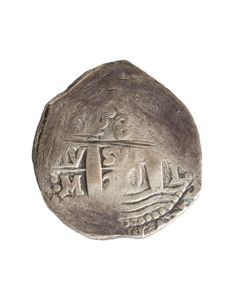 Rare 8 Reales cob coin
Rare 8 Reales cob coinLima, struck 1717 under Philipp V. Very fine, nice quality and preservation for a cob coin. Also known as piece of eight or pirate money.
Price: on request Mochica stirrup vessel as a shaman
Mochica stirrup vessel as a shamanImposing Peruvian vessel shaped like a priest on a podest with rich adornments. Circa 100 to 500 AD. With documents form the 1980ies.
Price: on request 8 Reales, also known as cob coin, piece of eight or pirate money
8 Reales, also known as cob coin, piece of eight or pirate moneyPotosi, Bolivia. Very fine, nice quality and preservation for a cob coin. This type of coins is also known as pieces of eight or pirate money
Price: on request Ceremonial knife of the Sican culture
Ceremonial knife of the Sican cultureThe so-called Tumi was a weapon to cut the throats of humans and animals in ritual sacrifices. The knife certainly fulfilled an additional representative function in the afterlife. From the period of the Sican's cultural florescence during the 10th to 12th centuries AD.
Price: on request Exceptionally well minted 8 Reales coin
Exceptionally well minted 8 Reales coinPotosi, Bolivia, ca. 1st half 17th century AD. This type of coins is also known as cob coins, pieces of eight or pirate money
Price: on request Stirrup vessel with lizzards
Stirrup vessel with lizzardsBeautiful vessel from the golden age of the Moche culture. It shows two lizzards on each side. 100 to 500 AD.
Price: on request Ceremonial knife of the Sican culture
Ceremonial knife of the Sican cultureThe so-called Tumi was a weapon to cut the throats of humans and animals in ritual sacrifices. The Tumi certainly fulfilled an additional representative function in the afterlife. From the period of the Sican's cultural florescence during the 10th to 12th centuries AD.
Price: on request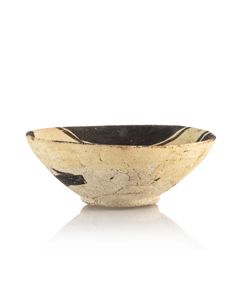 Bowl of the Chancay culture
Bowl of the Chancay cultureFlat pottery bowl with abstract painting on the inside. The pre-Columbian art of the Chancay seems simple at first, but radiates an elegance that still seems modern today.
Price: on request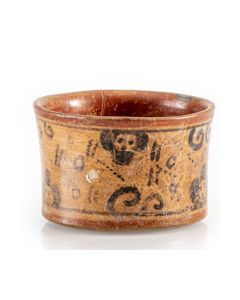 Maya civilization pottery bowl
Maya civilization pottery bowlSmall bowl painted with abstract shapes. From the Classic period of the Maya civilization.
Price: on request Bowl of the Chancay culture
Bowl of the Chancay cultureFlat pottery bowl with abstract painting. The pre-Columbian art of the Chancay seems simple at first, but radiates an elegance that still seems modern today.
Price: on request Small ceremonial knife of the Sican culture
Small ceremonial knife of the Sican cultureThe so-called Tumi was a weapon to cut the throats of humans and animals in ritual sacrifices. The knife certainly fulfilled an additional representative function in the afterlife. From the period of the Sican's cultural florescence during the 10th to 12th centuries AD.
Price: on request Bowl of the Chancay culture
Bowl of the Chancay cultureThin-walled pottery bowl with abstract painting and plastic animal head handles. The pre-Columbian art of the Chancay seems simple at first, but radiates an elegance that still seems modern today.
Price: on request Ceremonial knife of the Sican culture
Ceremonial knife of the Sican cultureThe so-called Tumi was a weapon to cut the throats of humans and animals in ritual sacrifices. The knife certainly fulfilled an additional representative function in the afterlife. From the period of the Sican's cultural florescence during the 10th to 12th centuries AD.
Price: on request Bowl of the Chancay culture
Bowl of the Chancay cultureThin-walled pottery bowl with abstract painting. The pre-Columbian art of the Chancay seems simple at first, but radiates an elegance that still seems modern today.
Price: on request Large ceremonial knife of the Sican culture
Large ceremonial knife of the Sican cultureThe so-called Tumi was a weapon to cut the throats of humans and animals in ritual sacrifices. The knife certainly fulfilled an additional representative function in the afterlife. From the period of the Sican's cultural florescence during the 10th to 12th centuries AD.
Price: on request Gourd shaped bowl of the Chimú culture
Gourd shaped bowl of the Chimú cultureElegant bowl with shiny black surface. Precolumbian pottery of the 10th to 15th century.
Price: on request Bowl of the Chancay culture
Bowl of the Chancay cultureFlat pottery bowl with abstract painting. The pre-Columbian art of the Chancay seems simple at first, but radiates an elegance that still seems modern today.
Price: on request Bowl of the Chancay culture
Bowl of the Chancay cultureThin-walled pottery bowl with abstract painting. The pre-Columbian art of the Chancay seems simple at first, but radiates an elegance that still seems modern today.
Price: on request Maya pottery bowl
Maya pottery bowlFlat bowl painted with mythical creatures. From the Classic period of the Maya civilization. Stunning object with lively colours.
Price: on request 8 Reales, also known as cob coin, piece of eight or pirate money
8 Reales, also known as cob coin, piece of eight or pirate moneyPotosi, Bolivia. Very fine, nice quality and preservation for a cob coin.
Price: on request Vessel of the Nazca culture
Vessel of the Nazca cultureMagnificent pottery of the Nazca with polychrome paint. It shows two condors. This piece comes with a copy of a TL report from 1984.
Price: on request Jama-Coaque roller stamp
Jama-Coaque roller stampClay roller stamp with relief of plants to be applied as skin decoration. This tool was used in the early phase of the ecuadorian Jama-Coaque culture.
Price: on request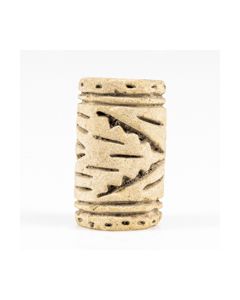 Jama-Coaque roller stamp
Jama-Coaque roller stampClay roller stamp with relief of stylized plants used to apply skin decoration. This tool is from the early phase of the ecuadorian Jama-Coaque culture.
Price: on request Stirrup vessel of a shaman
Stirrup vessel of a shamanBeautiful vessel from the golden age of the Moche culture. It shows a blind Shaman with a rattle in his hand. 200 to 400 AD, including TL analysis.
Price: on request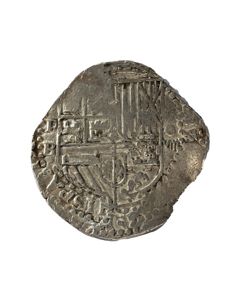 8 Reales, also known as cob coin, piece of eight or pirate money
8 Reales, also known as cob coin, piece of eight or pirate moneyPotosi, Bolivia. Very fine, rare quality and preservation for a cob coin.
Price: on request Jama-Coaque roller stamp
Jama-Coaque roller stampClay roller stamp with relief of mythological creatures to be applied as a skin decoration. This tool was used in the early phase of the ecuadorian Jama-Coaque culture and was found in Pedernales.
Price: on request Jama-Coaque roller stamp
Jama-Coaque roller stampClay roller stamp with rich ornamental relief to apply skin decoration. This tool was used in the early phase of the ecuadorian Jama-Coaque culture.
Price: on request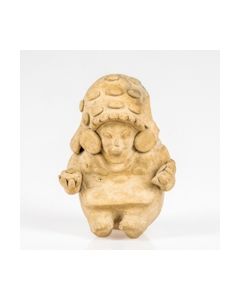 Sculpture of a Jama-Coaque chieftain
Sculpture of a Jama-Coaque chieftainThe clay figure from the earliest phase of the Jama-Coaque culture shows the preparation of coca leaves. Including TL test from Kotalla laboratory.
Price: on request Mochican stirrup vessel with museum provenance
Mochican stirrup vessel with museum provenanceElegant vessel of the late Moche culture. Wonderful geometrical decoration in near perfect condition.
Price: on request

